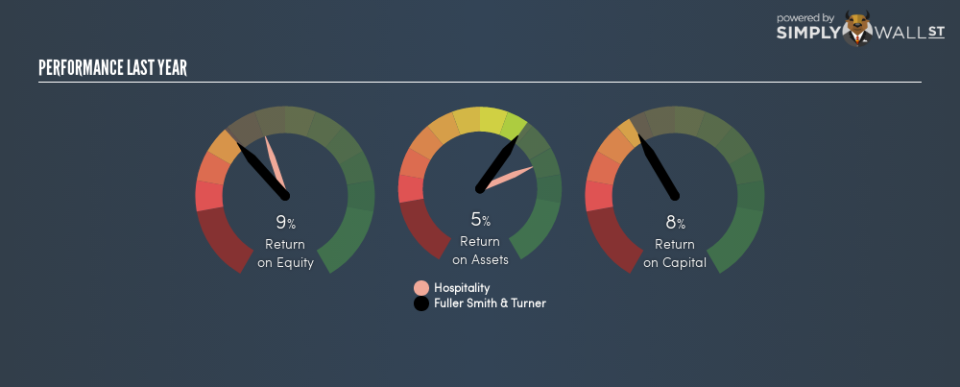Does Fuller, Smith & Turner P.L.C. (LON:FSTA) Create Value For Shareholders?

Want to participate in a short research study? Help shape the future of investing tools and you could win a $250 gift card!
Today we’ll look at Fuller, Smith & Turner P.L.C. (LON:FSTA) and reflect on its potential as an investment. Specifically, we’re going to calculate its Return On Capital Employed (ROCE), in the hopes of getting some insight into the business.
First, we’ll go over how we calculate ROCE. Next, we’ll compare it to others in its industry. And finally, we’ll look at how its current liabilities are impacting its ROCE.
Return On Capital Employed (ROCE): What is it?
ROCE measures the amount of pre-tax profits a company can generate from the capital employed in its business. In general, businesses with a higher ROCE are usually better quality. Ultimately, it is a useful but imperfect metric. Author Edwin Whiting says to be careful when comparing the ROCE of different businesses, since ‘No two businesses are exactly alike.’
How Do You Calculate Return On Capital Employed?
The formula for calculating the return on capital employed is:
Return on Capital Employed = Earnings Before Interest and Tax (EBIT) ÷ (Total Assets – Current Liabilities)
Or for Fuller Smith & Turner:
0.083 = UK£49m ÷ (UK£719m – UK£127m) (Based on the trailing twelve months to September 2018.)
Therefore, Fuller Smith & Turner has an ROCE of 8.3%.
See our latest analysis for Fuller Smith & Turner
Does Fuller Smith & Turner Have A Good ROCE?
ROCE can be useful when making comparisons, such as between similar companies. Using our data, Fuller Smith & Turner’s ROCE appears to be around the 8.5% average of the Hospitality industry. Separate from how Fuller Smith & Turner stacks up against its industry, its ROCE in absolute terms is mediocre; relative to the returns on government bonds. Readers may find more attractive investment prospects elsewhere.
When considering this metric, keep in mind that it is backwards looking, and not necessarily predictive. ROCE can be misleading for companies in cyclical industries, with returns looking impressive during the boom times, but very weak during the busts. ROCE is, after all, simply a snap shot of a single year. Future performance is what matters, and you can see analyst predictions in our free report on analyst forecasts for the company.
What Are Current Liabilities, And How Do They Affect Fuller Smith & Turner’s ROCE?
Current liabilities include invoices, such as supplier payments, short-term debt, or a tax bill, that need to be paid within 12 months. Due to the way ROCE is calculated, a high level of current liabilities makes a company look as though it has less capital employed, and thus can (sometimes unfairly) boost the ROCE. To check the impact of this, we calculate if a company has high current liabilities relative to its total assets.
Fuller Smith & Turner has total liabilities of UK£127m and total assets of UK£719m. Therefore its current liabilities are equivalent to approximately 18% of its total assets. This very reasonable level of current liabilities would not boost the ROCE by much.
What We Can Learn From Fuller Smith & Turner’s ROCE
If Fuller Smith & Turner continues to earn an uninspiring ROCE, there may be better places to invest. You might be able to find a better buy than Fuller Smith & Turner. If you want a selection of possible winners, check out this free list of interesting companies that trade on a P/E below 20 (but have proven they can grow earnings).
For those who like to find winning investments this free list of growing companies with recent insider purchasing, could be just the ticket.
To help readers see past the short term volatility of the financial market, we aim to bring you a long-term focused research analysis purely driven by fundamental data. Note that our analysis does not factor in the latest price-sensitive company announcements.
The author is an independent contributor and at the time of publication had no position in the stocks mentioned. For errors that warrant correction please contact the editor at editorial-team@simplywallst.com.

